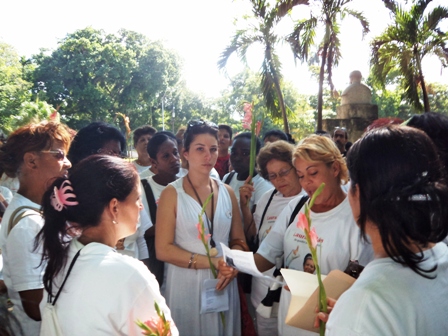In Cuba
Both Hispanic and Latino are typically used to indicate folks living in the United States,[three][four] so much in order that «Outside the United States, we don’t communicate of Latinos; we converse of Mexicans, Cubans, Puerto Ricans, and so forth.»[5][6] In Latin America, the term latino just isn’t a standard endonym and its usage in Spanish as a demonym is restricted to the Latin American-descended inhabitants of the United States. Other federal and local authorities businesses and non-revenue organizations embody Brazilians and Portuguese of their definition of Hispanic. The U.S. Department of Transportation defines Hispanic Americans as, «persons of Mexican, Puerto Rican, Cuban, Dominican, Central or South American, or different Spanish or Portuguese tradition or origin, regardless of race».[23] This definition has been adopted by the Small Business Administration as well as by many federal, state, and municipal companies for the purposes of awarding government contracts to minority owned companies. The Congressional Hispanic Caucus and the Congressional Hispanic Conference include representatives of Spanish and Portuguese descent.
During the 18th, nineteenth and early part of the 20th century, there have been waves of Spanish immigration to Cuba (Castilians, Basques, Canarians, Catalans, Andalusians, Asturians and Galicians). Canarians immigrated to many countries alongside the Caribbean from Louisiana to Venezuela. But Cuba was the Latin American culture most affected by the emigration of Canary Islanders (they developed the production of sugar in Cuba), and Cuban Spanish is closest to that of the Canary Islands. Canary Islanders were considered by different Spanish-Cubans as superstitious but in addition onerous-working. Some of Haiti’s white population (French) migrated to Cuba after the Haitian War of Independence within the early 18th century.

Outside the United States
Other famous Cuban drinks include guarapo de caña. In 1885, Vicente Martinez Ybor moved his cigar operations from Key West to the town meet cuban ladies of Tampa, Florida to escape labor strife.
In 1998, Witnesses were permitted to satisfy at bigger conventions in major cities in Cuba. The Afro-Cuban healers and Spanish curanderos served as the one medical practitioners in Cuba and had been liable for treating both the black and white population.[20] The distance between the town and the countryside made it very troublesome for slaves to participate in the syncretism of Santeria with Catholicism and Christianity.
Slavery in Cuba
They are descendants of Afro-Cuban troopers delivered to the country in 1975 as a result of the Cuban involvement in the Cold War. Fidel Castro deployed thousands of troops to the country during the Angolan Civil War. As a results of this era, there exists a small Spanish-talking neighborhood in Angola of Afro-Cubans numbering about a hundred,000. Castro initially is and all the time has been a dedicated egalitarian. He despises any system in which one class or group of people lives much better than one other.
After the revolution, Cuba turned an formally atheistic state and restricted non secular follow. Since the Fourth Cuban Communist Party Congress in 1991, restrictions have been eased and, according to the National Catholic Observer, direct challenges by state establishments to the best to faith have all but disappeared,[four] though the church still faces restrictions of written and digital communication, and can solely settle for donations from state-permitted funding sources.[4] The Roman Catholic Church is made up of the Cuban Catholic Bishops’ Conference (COCC), led by Jaime Lucas Ortega y Alamino, Cardinal Archbishop of Havana. )[1] is a noun and adjective often utilized in English and Spanish to discuss with individuals in the United States with cultural ties to Latin America, specifically to these international locations that are Spanish- or Portuguese-speaking. They have been educated and trusted to carry out skilled labor and given a substantial amount of duty.
La Virgen de la Caridad del Cobre (Our Lady Of Charity) is the Catholic patroness of Cuba, and is greatly revered by the Cuban individuals and seen as an emblem of Cuba. In Santería, she has been syncretized with the goddess Ochún.
Religion in Cuba

Both writers were part of the negrista or negrismo literary movement of the 20th century. This was a Hispanophone effort to reclaim Cuban blackness and connections to African tradition, while expressing a new sensibility (it was a motion just like the flowering of the American Harlem Renaissance in New York). Guillén, Cabrera, and their contemporaries revisited and tried to make sense of slavery and the crimes in opposition to the Afro-Cuban people, as well as celebrate the individuals who had survived and created their own culture. In 1511, Diego Velázquez de Cuéllar set out with three ships and a military of 300 men from Hispaniola to type the primary Spanish settlement in Cuba, with orders from Spain to conquer the island.
United States (American)
He is finest generally known as the founder, chief govt officer, and president of Amazon. The first centi-billionaire on the Forbes wealth index, Bezos was named the «richest man in fashionable historical past» after his internet value increased to $150 billion in July 2018.[four] In September 2018, Forbes described him as «far richer than anyone else on the planet» as he added $1.8 billion to his web worth when Amazon became the second firm in history to succeed in a market cap of $1 trillion. Cuba is historically a Catholic country. The Roman Catholic religion was delivered to Cuba by Spanish colonialists firstly of the 16th century, is essentially the most prevalent professed faith.
Eduardo Aguirre (R) served as Vice Chairman of the Export-Import Bank of the United States in the George W. Bush administration and later named Director of Immigration and Naturalization Services under the Department of Homeland Security. In 2006, Eduardo Aguirre was named US ambassador to Spain.